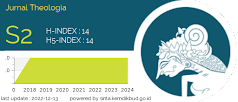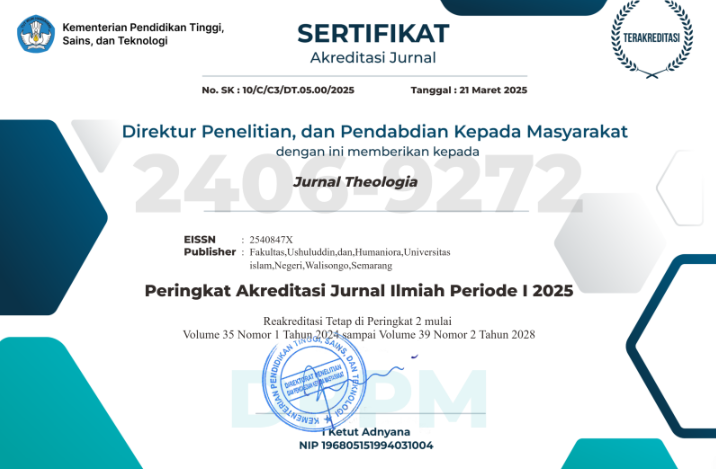Lamentations and Hopes of Conflict Victims in Sayyidi Ar-Rais Song (Michael Riffaterre Semiotic Analysis)
DOI:
https://doi.org/10.21580/teo.2022.33.2.17429Keywords:
Arabic Song, Sayyidi ar-Rais, Conflict, Semiotics.Abstract
This article aims to analyse the lyrics of an Arabic song entitled Sayyidi ar-Rais by Heba Meshary Hamada using Michael Riffaterre's semiotic theory. The song tells about the conflict between Israel and Palestine. The Israeli- Palestinian conflict that has caught the world's attention, through this song Heba M.H wants to convey a message which is her self-expression of the phenomenon that is happening. She tries to describe the situation and condition of the Palestinian people during the conflict. By using Michael Riffaterre's semiotic theory, the researcher wants to dig deeper into the meanings contained in the lyrics of the song Sayyidi ar-Rais. This research is a qualitative-descriptive research with the type of library research where the data obtained comes from literary sources related to the material objects and formal objects used. Based on the results of an analysis of the lyrics of the song Sayyidi ar-Rais using Michael Riffaterre's semiotic theory, namely through heuristic and hermeneutic reading, it was found that the song Sayyidi ar-Rais describes the lamentation of a Palestinian child who tells of the suffering he and the Palestinian people are experiencing as a result of the conflict with Israel, and hopes for freedom and peace for the land of Palestine and also for its people.
Downloads
References
Abud, Samir dan Heba Meshary Hamada, Sayyidi Ar-Rais (Zain Rmadhan 2018 Commercial) (Kuwait, 2018) <https://youtu.be/JIJB7cv97Dg>
Fakhruddin, Emilia Palupi Nurjannah. M, ‘Deklarasi Balfour : Awal Mula Konflik Israel Palestina’, Jurnal Sejarah Dan Pendidikan Sejarah, 1.1 (2019), 15–26.
Haikal, Yusuf, ‘Analisis Semiotika Michael Riffaterre Pada Puisi Īkbarī ‘Īsyrīna ‘Ᾱman Karya Nizar Qabbani / Michael Riffaterre’s Semiotic Analysis on the Poetry Ikbarī ’Īsyrīna ’Ᾱman by Nizar Qabbani’, Diwan : Jurnal Bahasa Dan Sastra Arab, 7.2 (2021), 160. <https://doi.org/10.24252/diwan.v7i2.20618>
Hasibuan, Sammad, ‘Nasionalisme Dalam Puisi Hanin Karya Ahmad Rami Dan Faruq Juwaidah (Sebuah Tinjauan Intertekstualitas)’, Tsaqofiya: Jurnal Pendidikan Bahasa Dan Sastra Arab, 4 (20222), 223–242.
Latifi, Yulia Nasrul, ‘PUISI ANA KARYA NAZIK AL-MALA’IKAH (Analisis Semiotik Riffaterre)’, Adabiyyāt: Jurnal Bahasa Dan Sastra, 12.1 (2013), 25. <https://doi.org/10.14421/ajbs.2013.12102>
Mukaromah, Zahrotul, Rika Astari, Salma Nuraeni, and Febriani Indah Wulandari, ‘Pengaruh Satra Musik Arab Modern Pada Lagu Sayyidi Ar-Rais Karya Hama Meshary Hamdana’, Lisanan Arabiya: Jurnal Pendidikan Bahasa Arab, 5.1 (2021), 13–34. <https://doi.org/10.32699/liar.v5i1.1695>
Nailarrochim, Noor, ‘Puisi Al-Kulira Karya Nazik Al-Malaikah (Studi Analisis Semiotika Michael Riffaterre)’, A Jamy: Jurnal Bahasa Dan Sastra Arab, 9 (2020).
Pradopo, Rachmat Djoko, Pengkajian Puisi: Analisis Strata Norma Dan Analisis Struktural Dan Semiotik (Yogyakarta: UGM Press, 2018).
Shihab, Alwi, Islam Inklusive: Menuju Sikap Terbuka Dalam Beragama (Bandung: Mizan, 1999).
Umairoh, Sherly Ulfa, ‘Analisis Semiotika Charles Morris Dalam Lagu Sayyidi Ar-Rais Karya Hama Meshary Hamada’, Tabuah, 26.1 (2022), 40–47. <https://doi.org/10.37108/tabuah.v26i1.683>
Wiyatmi, Pengantar Kajian Sastra (Yogyakarta: Pustaka Pelajar, 2006).




















